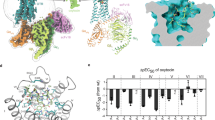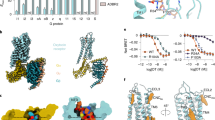Abstract
We report the solid-phase synthesis and receptor-binding properties of eleven oxytocin analogs (Mpa-Xxx-Ile-Gln-Asn-Cys-Sar-Arg-Gly-NH2) containing non-coded amino acids in position 2: D-α- and L-α-(2-indanyl)glycine, R,S-6-methoxy-2-aminotetralin-2-carboxylic acid, D- and L-pentafluorophenylalanine, D,L-2,4-dimethylphenylalanine, D,L-2,4,6-trimethylphenylalanine, R,R- and S,S-1,2,3,4-tetrahydro-1-methyl-β-carboline-3-carboxylic acid and R- and S-1,2,3,4-tetrahydro-β-carboline-3-carboxylic acid. Some of these amino acid analogs (2-indanylglycine and D-pentafluorophenylalanine) were earlier successfully applied for the synthesis of potent bradykinin antagonists [1,2]. Their receptor bindings were tested on isolated guinea-pig uterus, rat liver and rat kidney inner medulla plasma membranes. The extent of binding of the peptides to the oxytocin receptor was in several cases was even higher than that of the parent hormone (oxytocin). However, the real pharmacological value of these analogs can be evaluated only after in vivo measurements of their inhibition of uterine motor activity.
Similar content being viewed by others
References
Reissmann, S., Pineda, F., Vietinghoff, G., Werner, H., Gera, L., Stewart, J.M. and Paegelow, I., Peptides, 21 (2000) 527.
Gera, L. and Stewart, J.M., Immunopharm., 33 (1996) 174.
IUPAC-IUB Joint Commission on Biochemical Nomenclature, J. Biol. Chem., 219 (1984) 345.
du Vigneaud, V., Ressler, C., Swan, J.M., Roberts, C.W., Katsoyannis, P.G. and Gordon S., J. Am. Chem. Soc., 75 (1953) 4879.
du Vigneaud, V., Lawler, H.C. and Popenoe, E.A., J. Am. Chem. Soc., 75 (1953) 4880.
Goodwin, T.M., Valenzuela, G.J., Silver, H. and Creasy, G., Obstet. Gynecol., 88 (1996) 331.
The Worldwide Atosiban versus Beta-agonists Study Group, Br. J. Obstet. Gynecol., 108 (2001) 133.
Grzonka, Z., Kasprzykowsky, F., Darlak, K., Hahn, T.A. and Spatola, A.F., Peptide Res., 4 (1991) 270.
Grzonka, Z., Lammek, B., Kasprzykowsky, F., Gazis, D. and Schwartz, I.L., J. Med. Chem., 26 (1983) 555.
Lebl, M., Analogs with inhibitory properties. In: Jost, K., Lebl, M. and Brtnik, F. (Eds) Handbook of Neurohypophiseal Hormone Analogs Vol. 2. Boca Raton, CRC Press, 1987, pp. 17–74.
Hruby, V.J., Chan, W.Y., Rockway, T.W., Hlavacek, J. and Ormberg, J. In: Channa Basava and G.M. Anantharamaiah (Eds) Peptides: Design, Synthesis and Biological Activity Birkhauser, Boston, 1994, pp. 199–208.
Manning, M., Cheng, L.L., Stoev, S., Bankowski, K., Przybylski, J., Klis, W.A., Sawyer, W.H., Wo, N.C. and Chan, W.Y., J. Pept. Sci., 1 (1995) 66.
Manning, M., Nawrocka, E., Misicka, A., Olma, A., Klis, W.A., Seto, J. and Sawyer, W.H., J. Med. Chem., 27 (1984) 423.
Porter, T.H. and Shive, W., J. Med. Chem., 11 (1968) 402.
Hofmann, K., Finn, F.M. and Kiso, Y., J. Am. Chem. Soc., 100 (1978) 3585.
Herr, R.R., Enkoji, T. and Dailey, J.P., J. Am. Chem. Soc., 79 (1957) 4229.
Porter, J., Dykert, J. and Rivier, J., Int. J. Peptide Protein Res., 30 (1987) 13.
Darula, Zs., Kövér, K., Monory, K., Borsodi, A., Makó, É., Rónai, A., Tourwé, D., Péter, A. and Tóth, G., J. Med. Chem., 43 (2000) 1459.
Brossi, A., Focella, A. and Teitel, S., J.Med. Chem., 16 (1973) 418.
Moroder, L., Hallett, S., Wünsch, E., Keller, O. and Wersin, G., Hoppe Seyler's Z. Physiol. Chem., 357 (1976) 1651.
Merrifield, R.B., J. Am. Chem. Soc., 85 (1963) 2149.
Kaiser, E., Colescott, R. L., Bossinger, C.D. and Cook, P.J., Anal. Chem., 1987.
Fuchs, A.R., Periyasami, S., Alexandrova, M. and Soloff, M.S., Endocrinology, 113 (1983) 742.
Marchingo, A.J.J., Abrahams, M., Woodcock, E.A., Smith, A.I., Mendelson, F.A.O. and Johnston, C.I., Endocrinology, 122/4 (1988) 1328.
Manning, M., Miteva, K., Pancheva, S., Stoev, S., Wo, N.C. and Chan, W.Y., Int. J. Pept. Prot. Res. 46 (1992) 244.
Manning, M., Lowbridge, J, Seto, J., Haldar, J. and Sawyer, W.H., J. Med. Chem., 21 (1978) 179.
Bankowski, K., Manning, M., Seto, J., Haldar, J. and Sawyer, W.H., Int. J. Pept. Prot. Res., 16 (1980) 382.
Tóth, G.K., Bakos, K., Penke, B., Pávó, I., Varga, Cs., Török, G., Péter, A. and Fülöp, F., Bioorg. Med. Chem. Lett., 9 (1999) 667.
Author information
Authors and Affiliations
Corresponding author
Rights and permissions
About this article
Cite this article
Bakos, K., Havass, J., Fülöp, F. et al. Synthesis and receptor binding of oxytocin analogs containing conformationally restricted amino acids. Letters in Peptide Science 8, 35–40 (2001). https://doi.org/10.1023/A:1014242727915
Issue Date:
DOI: https://doi.org/10.1023/A:1014242727915




